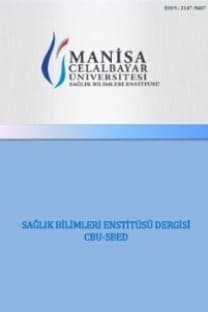Yüksek Gerçeklikli Hasta Simülatöründe Eğitim: Hemşirelik Öğrencilerinin Memnuniyeti Ve Öğrenmede Kendine Güvenlerinin Değerlendirilmesi
Simülasyon, hemşirelik öğrencisi, kendine güven
Educatıon In The Hıgh Realıstıc Patıent Sımulator: The Assessment Of The Satısfactıon And Self-Relıabılıty In Learnıng Of Nursıng Students
Simulation, nursing student, self-confidence,
___
- 1. Park H, Yu S. Policy issues in simulation-based nursing education and technology development. Health Policy and Technology 2018; 7(3): 318–321.
- 2. Terzioğlu F, Kapucu S, Özdemir L, Boztepe H, Duygulu S, Tuna Z, Akdemir N. Simülasyon yöntemine ilişkin hemşirelik öğrencilerinin görüşleri. Hacettepe Üniversitesi Sağlık Bilimleri Fakültesi Hemşirelik Dergisi 2012; 16-23.
- 3. Edeer Durmaz A, Sarıkaya A. Hemşirelik eğitiminde simülasyon kullanımı ve simülasyon tipleri. Hemşirelikte Eğitim Ve Araştırma Dergisi 2015; 12 (2): 121-125.
- 4. Bogossianae F, Cooper S, Kelly M, Levett-Jones T, McKennaae L, Slark J, Seatong P. Best practice in clinical simulation education − are we there yet? A cross-sectional survey of simulation in Australian and New Zealand pre-registration nursing education. Collegian 2018; 25(3): 327-334.
- 5. Karaçay P, Kaya H. Simülasyonla eğitimde kullanılan Öğrenci Memnuniyeti Ve Öğrenmede Kendine Güven Ölçeği’nin Türkçe’ye uyarlanması. Florence Nightingale Hemşirelik Dergisi 2017; 25(2): 95-103.
- 6. The International Nursing Association for Clinical Simulation and Learning (INACSL). INACSL standards of best practice: Simulation_Simulation design. Clinical Simulation in Nursing 2016;12: 1- 50.
- 7. Uzelli Yılmaz D, Akın Korhan E. Hemşirelik eğitiminde simülasyon yönteminin etkinliği: bir sistematik inceleme. Türkiye Klinikleri J Nurs Sci 2017; 9(3):218-226.
- 8. Ömer T. Nursing students’ perceptions of satisfaction and self-confidence with clinical simulation experience. Journal of Education and Practice 2016;7(5):131-138.
- 9. Kim MY, Park S. Associations of stress, self-esteem, and collective efficacy with flow in simulation among nursing students: A descriptive cross-sectional study. Nurse Education Today 2018;71:193-197.
- 10. Padilha JM, Machado PP, Ribeiro AL, Ramos JL. Clinical virtual simulation in nursing education. Clinical Simulation in Nursing 2018; 15: 13-18.
- 11. Crowe S, Ewart L, Derman S. The impact of simulation based education on nursing confidence, knowledge and patient outcomes on general medicine units. Nurse Education Today 2018; 29:70-75.
- 12. Lee H, Park J, Kim S, Han J. Cortisol as a predictor of simulation-based educational outcomes in senior nursing students: A pilot study. Clin Simul Nurs 2016;12(2):44-8.
- 13. Cummings C, Connelly LK. Can nursing students' confidence levels increase with repeated simulation activities?. Nurse Education Today 2016; 36: 419–421.
- 14. Laschinger S, Medves J, Pulling C, McGraw DR, Waytuck B, Harrison MB, Gambeta K. Effectiveness of simulation on health profession students' knowledge, skills, confidence and satisfaction. Int J Evid Based Healthc 2008; 6(3):278-302.
- 15. Alinier G, Hunt B, Gordon R, Harwood C. Effectiveness of intermediate-fidelity simulation training technology in undergraduate nursing education. J Adv Nurs. 2006; 54(3):359-369.
- 16. Bearnson CS, Wiker KM. Human patient simulators: a new face in baccalaureate nursing education at Brigham Young University. J Nurs Educ. 2005;44(9):421-425.
- 17. Hicks FD, Merritt SL, Elstein AS. Critical thinking and clinical decision making in critical care nursing: a pilot study. Heart and Lung 2003; 32: 169-180.
- 18. Hart P, Spira L, Moreno N. Psychometric properties of clinical decision making self-confidence scale. Journal of Nursing Management 2014; 22: 312-322.
- 19. Australian Commission on Quality and Safety in Healthcare (ACSQHC). National Consensus Statement: Essential Elements for recognizing and responding to clinical deterioration. Canberra Australia 2010.
- ISSN: 2147-9607
- Yayın Aralığı: 4
- Başlangıç: 2014
- Yayıncı: Manisa Celal Bayar Üniversitesi Sağlık Bilimleri Enstitüsü
Kanser hücreleri üzerine Origanum minutiflorum’un Sitotoksik Etkisinin Araştırılması
OKTAY ÖZKAN, CANER ÖZBEY, IŞIL AYDEMİR, İSMAİL SARI, GONCA DÖNMEZ ARAT, Fatma Esi̇n KIRIK, Ahmet SAVRAN, MEHMET İBRAHİM TUĞLU
Pediatri Hemşirelerinin Çocuk Haklarına Yönelik Tutumlarının Belirlenmesi
DİLEK KÜÇÜK ALEMDAR, GAMZE YILMAZ
Atletik Performans ve Spor Genetiği
Nurten DİNÇ, Mehmet Hilmi GÖKMEN
Kaudal Blok Uygulanan Pediatrik Hastalarda Ultrason İle Konvansiyonel Kör Tekniğin Karşılaştırılması
Zeynep Gizem KAYA İSLAMOĞLU, Abdullah DEMİRBAŞ
ZEYNEP GİZEM KAYA İSLAMOĞLU, Abdullah DEMİRBAŞ
Serebral Venöz Trombozda Trombosit Aktivasyonu ile Rekanalizasyon Süresi İlişkisi
